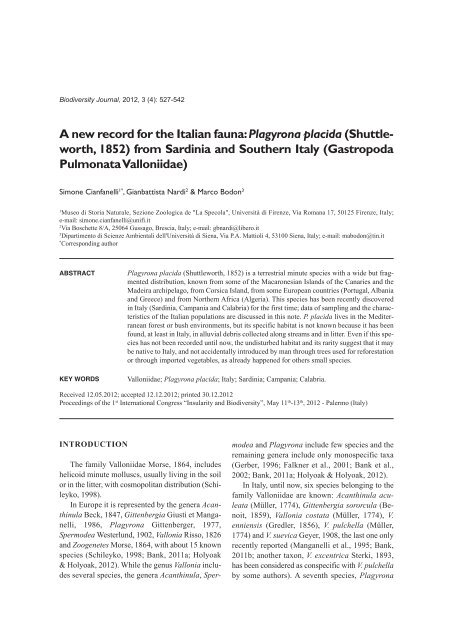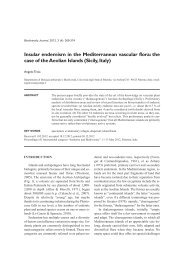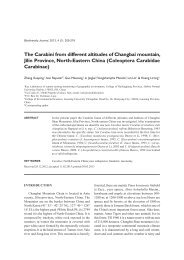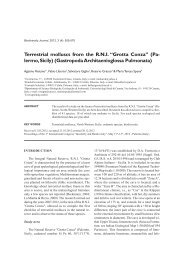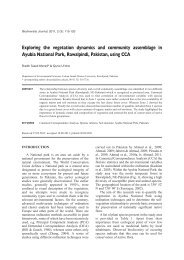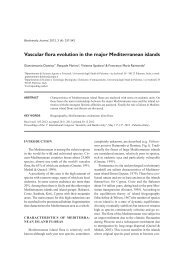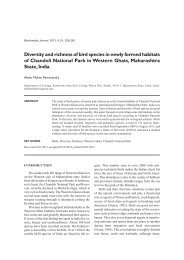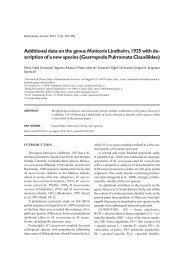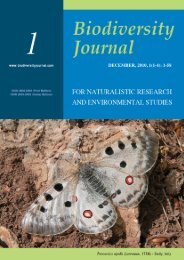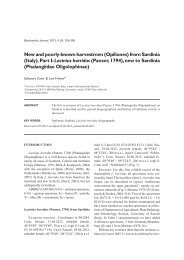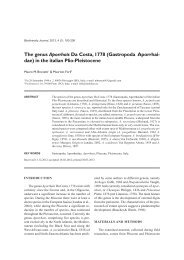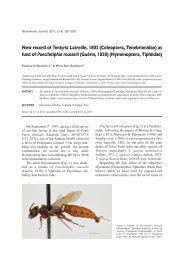Plagyrona placida - Biodiversity Journal
Plagyrona placida - Biodiversity Journal
Plagyrona placida - Biodiversity Journal
Create successful ePaper yourself
Turn your PDF publications into a flip-book with our unique Google optimized e-Paper software.
<strong>Biodiversity</strong> <strong>Journal</strong>, 2012, 3 (4): 527-542<br />
A new record for the Italian fauna: <strong>Plagyrona</strong> <strong>placida</strong> (Shuttleworth,<br />
1852) from Sardinia and Southern Italy (Gastropoda<br />
Pulmonata Valloniidae)<br />
Simone Cianfanelli 1* , Gianbattista Nardi 2 & Marco Bodon 3<br />
1<br />
Museo di Storia Naturale, Sezione Zoologica de "La Specola", Università di Firenze, Via Romana 17, 50125 Firenze, Italy;<br />
e-mail: simone.cianfanelli@unifi.it<br />
2<br />
Via Boschette 8/A, 25064 Gussago, Brescia, Italy; e-mail: gbnardi@libero.it<br />
3<br />
Dipartimento di Scienze Ambientali dell'Università di Siena, Via P.A. Mattioli 4, 53100 Siena, Italy; e-mail: mabodon@tin.it<br />
*<br />
Corresponding author<br />
ABSTRACT<br />
<strong>Plagyrona</strong> <strong>placida</strong> (Shuttleworth, 1852) is a terrestrial minute species with a wide but fragmented<br />
distribution, known from some of the Macaronesian Islands of the Canaries and the<br />
Madeira archipelago, from Corsica Island, from some European countries (Portugal, Albania<br />
and Greece) and from Northern Africa (Algeria). This species has been recently discovered<br />
in Italy (Sardinia, Campania and Calabria) for the first time; data of sampling and the characteristics<br />
of the Italian populations are discussed in this note. P. <strong>placida</strong> lives in the Mediterranean<br />
forest or bush environments, but its specific habitat is not known because it has been<br />
found, at least in Italy, in alluvial debris collected along streams and in litter. Even if this species<br />
has not been recorded until now, the undisturbed habitat and its rarity suggest that it may<br />
be native to Italy, and not accidentally introduced by man through trees used for reforestation<br />
or through imported vegetables, as already happened for others small species.<br />
KEY WORDS<br />
Valloniidae; <strong>Plagyrona</strong> <strong>placida</strong>; Italy; Sardinia; Campania; Calabria.<br />
Received 12.05.2012; accepted 12.12.2012; printed 30.12.2012<br />
Proceedings of the 1 st International Congress “Insularity and <strong>Biodiversity</strong>”, May 11 th -13 th , 2012 - Palermo (Italy)<br />
INTRODUCTION<br />
The family Valloniidae Morse, 1864, includes<br />
helicoid minute molluscs, usually living in the soil<br />
or in the litter, with cosmopolitan distribution (Schileyko,<br />
1998).<br />
In Europe it is represented by the genera Acanthinula<br />
Beck, 1847, Gittenbergia Giusti et Manganelli,<br />
1986, <strong>Plagyrona</strong> Gittenberger, 1977,<br />
Spermodea Westerlund, 1902, Vallonia Risso, 1826<br />
and Zoogenetes Morse, 1864, with about 15 known<br />
species (Schileyko, 1998; Bank, 2011a; Holyoak<br />
& Holyoak, 2012). While the genus Vallonia includes<br />
several species, the genera Acanthinula, Spermodea<br />
and <strong>Plagyrona</strong> include few species and the<br />
remaining genera include only monospecific taxa<br />
(Gerber, 1996; Falkner et al., 2001; Bank et al.,<br />
2002; Bank, 2011a; Holyoak & Holyoak, 2012).<br />
In Italy, until now, six species belonging to the<br />
family Valloniidae are known: Acanthinula aculeata<br />
(Müller, 1774), Gittenbergia sororcula (Benoit,<br />
1859), Vallonia costata (Müller, 1774), V.<br />
enniensis (Gredler, 1856), V. pulchella (Müller,<br />
1774) and V. suevica Geyer, 1908, the last one only<br />
recently reported (Manganelli et al., 1995; Bank,<br />
2011b; another taxon, V. excentrica Sterki, 1893,<br />
has been considered as conspecific with V. pulchella<br />
by some authors). A seventh species, <strong>Plagyrona</strong>
528<br />
S. CIANFANELLI, G. NARDI & M. BODON<br />
<strong>placida</strong> (Shuttleworth, 1852), is now reported in<br />
this paper from Sardinia, Campania and Calabria.<br />
P. <strong>placida</strong> has a fairly wide but fragmented distribution,<br />
having been reported for the Canary Islands<br />
(El Hierro, La Gomera, La Palma, Tenerife)<br />
(Wollaston, 1878; Ibáñez et al., 2001; Bank et al.,<br />
2002; Brito & Fraga, 2010), the islands of Madeira<br />
and Porto Santo (Wollaston, 1878; Waldén, 1983;<br />
Bank et al., 2002; Cameron et al., 2007; Seddon,<br />
2008), Portugal (Servain, 1880; Silva e Castro,<br />
1887; Locard, 1899; Gittenberger, 1977; Oliveira,<br />
2008, 2009, 2010; Torres & Oliveira, 2010; Bank,<br />
2011a; Holyoak & Holyoak, 2012), Corsica (Ripken<br />
& Bouchet, 1998; Falkner et al., 2002), Albania<br />
(Reischhütz et al., 2008; Ferhér & Eróss, 2009;<br />
Bank, 2011c) and Greece (Gittenberger, 1989;<br />
Bank, 2011d); moreover, it was also surveyed in<br />
north-eastern Africa, in Algeria (Bourguignat, 1863,<br />
1864; Gittenberger, 1977).<br />
Being of small size, rather rare and localized,<br />
therefore difficult to find, P. <strong>placida</strong> might have<br />
escaped non specific searches performed in other<br />
countries, so that its known distribution may have<br />
been underestimated. In Madeira and Porto Santo<br />
the species has been found also as a fossil (Cook et<br />
al., 1993; Cameron et al., 2006) so, in these places,<br />
it is undoubtedly to be considered a native species;<br />
on the other hand, in other countries, its autochthony<br />
is not proven with certainty, even if there<br />
are no elements in favour of a passive diffusion.<br />
Historical notes<br />
"Helix <strong>placida</strong>" was described by Shuttleworth<br />
(1852) on the basis of some specimens found on the<br />
island of Tenerife, in the Canary archipelago. A second<br />
description of this entity was made by Bourguignat<br />
(1863) who, collecting this minute snail in<br />
Algeria, named it "Helix debeauxiana" (taxon now<br />
acknowledged as a junior synonym of <strong>Plagyrona</strong><br />
<strong>placida</strong>; Waldén, 1983). Lowe (1855) established a<br />
"variety" of "Helix pusilla", taxon described by him<br />
some years before from Madeira (Lowe, 1831),<br />
which he called "Helix pusilla var. β. sericina". But,<br />
whereas "Helix pusilla" Lowe, 1831 is a younger<br />
synonym of Paralaoma servilis (Shuttleworth,<br />
1852) (Falkner et al., 2002), the new taxon "Helix<br />
pusilla var. β. sericina" can be attributed to <strong>Plagyrona</strong><br />
<strong>placida</strong> (Bank et al., 2002).<br />
Then reports of "Helix debeauxiana" followed<br />
from Portugal (Servain, 1880) and descriptions of<br />
"Helix luseana" (Paiva, 1866) from the island of<br />
Madeira and "Helix bussacona" (Silva e Castro,<br />
1887) from Portugal, too, all nowadays considered<br />
as synonyms of the species (Gittenberger, 1977;<br />
Bank et al., 2002).<br />
Gittenberger (1977) described the new genus <strong>Plagyrona</strong>,<br />
on the basis of the peculiar spiral micro-sculpture<br />
on protoconch and teleoconch of the shell, to<br />
separate "Helix debeauxiana" by the others Valloniidae.<br />
In that work he briefly described also the radula.<br />
In the last decades P. <strong>placida</strong> was surveyed for<br />
the fauna of France, having been found in a site of<br />
Corsica, near Coti-Chiavari, in the SW of the island<br />
(Ripken & Bouchet, 1998), in an Albanian site, placed<br />
E of Rrogozhine (Reischütz et al., 2008) and in<br />
Greece, in the Ionian islands of Kerkyra, Ithaca and<br />
Cephalonia (Gittenberger, 1989).<br />
Finally, Holyoak & Holyoak (2012) have recently<br />
separated the populations of Portugal into two<br />
different taxa, with the description of a new species<br />
<strong>Plagyrona</strong> angusta Holyoak & Holyoak, 2012. This<br />
species has been established on a few morphometric<br />
characters of the shell, as a narrower diameter and<br />
a smaller umbilicus, and, even though it is not always<br />
well distinguishable from P. <strong>placida</strong>, the sympatry<br />
of the two taxa may support its distinct<br />
specific status. Unfortunately, even if the authors<br />
found living specimens of both taxa, they have not<br />
reported any anatomical data and therefore the anatomy<br />
of <strong>Plagyrona</strong> is still unknown, so the allocation<br />
of this genus to the family Valloniidae still has<br />
some margin of uncertainty.<br />
While for the European Mediterranean areas no<br />
detailed information about the habitat of collection<br />
of P. <strong>placida</strong> is available, it is known for Portugal,<br />
Algeria and for the Macaronesian Islands. In Portugal<br />
the specimens have been sieved from leaf-litter<br />
on rocky slopes of limestone covered by bushes<br />
and herbs (Seddon & Tattersfield, 1992) or in<br />
humid rocky limestone habitats underneath deciduous<br />
woodlands, on trunks and branches covered<br />
with epiphytic mosses or on low limestone rocks<br />
covered of mosses (Holyoak & Holyoak, 2012). In<br />
Algeria the species has been found under leaves,<br />
among hypnoid mosses covering oak trees, preferring<br />
upper sides of large horizontal branches (Bourguignat,<br />
1863; Letorneux, 1870), while in the<br />
islands of Madeira and in the Canary Islands the<br />
species has been found in laurel forests on mosses<br />
and lichens on damp trunks (Shuttelworth, 1852;
A new record for the Italian fauna: <strong>Plagyrona</strong> <strong>placida</strong> from Sardinia and S. Italy (Gastropoda Pulmonata Valloniidae)<br />
529<br />
Paiva, 1866; Wollaston, 1878), in rocky sites above<br />
the ground on damp tree trunks or in leaf-litter or<br />
in litters, mosses and branches of laurels (Seddon<br />
& Holyoak, 1993; Seddon, 2008) or in humid laurel<br />
forests or Erica arborea L. scrubs, on mosses or<br />
trunks (Holyoak & Holyoak, 2012).<br />
MATERIALS AND METHODS<br />
Shells of P. <strong>placida</strong> were collected in alluvial<br />
debris or in litter: the sediments were sieved using<br />
decreasing mesh sieves and the specimens were separated<br />
visually or using a binocular microscope.<br />
The photographs of the shells have been taken<br />
with the aid of a binocular microscope and related<br />
software. Details of the protoconch and teleoconch<br />
were obtained from samples mounted on aluminium<br />
supports covered by conductive glue, sputtercoated<br />
with graphite and gold, and examined using<br />
a scanning electron microscope (SEM). All dimensions<br />
(shells height, shells diameter, aperture height<br />
and aperture diameter) were measured using a micrometer<br />
in the light microscope.<br />
The collection data are listed as follows: locality,<br />
altitude, municipality and abbreviation of the province<br />
in parentheses, UTM coordinates (ED 50),<br />
collectors and dates, number of specimens in parentheses.<br />
Names of the localities were taken from the<br />
official map of Italy by I.G.M.I.; UTM coordinates<br />
were taken from the same maps or detected by GPS.<br />
The examined material is presently preserved in<br />
the following collections: Museo di Storia Naturale<br />
dell'Università di Firenze, sezione di Zoologia de<br />
"La Specola", Via Romana 17, Florence, Italy<br />
(MZUF); M. Bodon, Via delle Eriche 100/8, Genoa,<br />
Italy, (MBC); S. Cianfanelli, Via Monferrato 3, Florence,<br />
Italy (SCC); E. Talenti, Piazza Parri 4, Incisa,<br />
Florence, Italy (ETC); G. Nardi, Via Boschette 8/A,<br />
Gussago, Brescia, Italy (GNC).<br />
RESULTS AND DISCUSSION<br />
<strong>Plagyrona</strong> <strong>placida</strong> (Shuttleworth, 1852)<br />
Helix <strong>placida</strong> Shuttleworth, 1852: 140<br />
Helix <strong>placida</strong>, Pfeiffer, 1853: 82-83<br />
Helix pusilla var. β. sericina Lowe, 1855: 176<br />
Helix Debeauxiana Bourguignat, 1863: 183-184,<br />
Pl. 19, figs. 13-16<br />
Helix Debeauxiana, Bourguignat, 1864: 308, 329<br />
Helix luseana Paiva, 1866: 342-343, Pl. 11, fig. 9<br />
Helix luseana, Paiva, 1867: 80, Pl. 2, fig. 3<br />
Helix Debeauxiana, Letourneux, 1870: 277, 279<br />
Patula <strong>placida</strong>, Pfeiffer, 1870: 40-41, 62, Pl. 120,<br />
figs. 9-12<br />
Patula <strong>placida</strong>, Mousson, 1872: 25, Pl. 2, figs. 9-12<br />
Helix <strong>placida</strong>, Pfeiffer, 1876: 139<br />
Patula <strong>placida</strong>, Wollaston, 1878: 63, 87-88, 282,<br />
331, 481, 570<br />
Helix Debeauxiana, Servain, 1880: 61-62<br />
Helix Debeauxiana, Silva e Castro, 1887: 246 (records<br />
to confirm according to Holyoak & Holyoak,<br />
2012)<br />
Helix bussacona Silva e Castro, 1887: 246<br />
Helix Debeauxiana, Tryon, 1887: 28-29, 275. Pl. 6,<br />
figs. 31-33<br />
Helix luseana, Tryon, 1887: 31, 275. Pl. 6, figs. 59-60<br />
Helix <strong>placida</strong>, Tryon, 1887: 51, 275. Pl. 9, fig. 94<br />
Helix (Punctum) debeauxiana, Westerlund, 1889: 8<br />
Helix (Punctum) bussacona, Westerlund, 1889: 9<br />
Pyramidula (Pyramidula) bussacona, Pilsbry,<br />
1894: 44<br />
Pyramidula (Pyramidula) debeauxiana, Pilsbry,<br />
1894: 44<br />
Patula (Punctum) debeauxi, Kobelt, 1898: 47, Pl.<br />
225, fig. 1434<br />
Helix bussacona, Kobelt, 1898: 47<br />
Helix Debeauxiana, Locard, 1899: 72<br />
Helix Bussacona, Locard, 1899: 73<br />
<strong>Plagyrona</strong> debeauxiana, Gittenberger, 1977: 297-<br />
303, Figs. 3, 4; Pl. 1, figs. 1, 2; Pl. 2, figs. 1-6<br />
<strong>Plagyrona</strong> <strong>placida</strong>, Waldén, 1983: 266, 268<br />
Planogyra sororcula, Palazzi, 1988: 17 (not Helix<br />
sororcula Benoit, 1859)<br />
<strong>Plagyrona</strong> <strong>placida</strong>, Gittenberger, 1989: 14, Figs. 4, 5<br />
<strong>Plagyrona</strong> <strong>placida</strong>, Cook et al., 1990: 50, 72, 74, 76<br />
<strong>Plagyrona</strong> <strong>placida</strong>, Fidalgo & Callopez, 1990: 80<br />
<strong>Plagyrona</strong> <strong>placida</strong>, Ripken & Bouchet, 1998: 15<br />
<strong>Plagyrona</strong> <strong>placida</strong>, Seddon & Tattersfield, 1992: 259<br />
(record from Algarve to confirm according to Holyoak<br />
& Holyoak, 2012)<br />
<strong>Plagyrona</strong> <strong>placida</strong>, Cook et al., 1993: 83, 93, 96,<br />
99-103<br />
<strong>Plagyrona</strong> <strong>placida</strong>, Seddon & Holyoak, 1993: 326<br />
<strong>Plagyrona</strong> <strong>placida</strong>, Goodfriend et al., 1994: 319<br />
<strong>Plagyrona</strong> <strong>placida</strong>, Schileyko, 1998: 98-99, Fig. 111<br />
<strong>Plagyrona</strong> <strong>placida</strong>, Cameron & Cook, 2001: 262<br />
<strong>Plagyrona</strong> <strong>placida</strong>, Falkner et al., 2001: 34<br />
<strong>Plagyrona</strong> <strong>placida</strong>, Ibáñez et al., 2001: 147
530<br />
S. CIANFANELLI, G. NARDI & M. BODON<br />
<strong>Plagyrona</strong> <strong>placida</strong>, Bank et al., 2002: 102, 140,<br />
151, 157, 174, 187, 195<br />
<strong>Plagyrona</strong> <strong>placida</strong>, Falkner et al., 2002: 37, 107<br />
<strong>Plagyrona</strong> <strong>placida</strong>, Albuquerque de Matos, 2004: 38<br />
<strong>Plagyrona</strong> <strong>placida</strong>, Cameron et al., 2006: 31-33, 35, 41<br />
<strong>Plagyrona</strong> <strong>placida</strong>, Cameron et al., 2007: 15, 19<br />
<strong>Plagyrona</strong> <strong>placida</strong>, Oliveira, 2008: 41 (records to<br />
confirm according to Holyoak & Holyoak,<br />
2012)<br />
<strong>Plagyrona</strong> <strong>placida</strong>, Reischütz et al., 2008: 38<br />
<strong>Plagyrona</strong> <strong>placida</strong>, Seddon, 2008: 37; Pl. 5D; Map<br />
37, 125<br />
<strong>Plagyrona</strong> <strong>placida</strong>, Fehér & Eróss, 2009: 27<br />
<strong>Plagyrona</strong> <strong>placida</strong>, Kappes et. al., 2009: 585<br />
<strong>Plagyrona</strong> <strong>placida</strong>, Oliveira, 2009: 55-56 (records<br />
to confirm according to Holyoak & Holyoak,<br />
2012)<br />
<strong>Plagyrona</strong> <strong>placida</strong>, Brito & Fraga, 2010: 188<br />
<strong>Plagyrona</strong> <strong>placida</strong>, Fontaine et al., 2010: 24<br />
<strong>Plagyrona</strong> <strong>placida</strong>, Oliveira, 2010: 42-43 (records<br />
to confirm according to Holyoak & Holyoak,<br />
2012)<br />
<strong>Plagyrona</strong> <strong>placida</strong>, Torres & Oliveira, 2010: 32 (records<br />
to confirm according to Holyoak & Holyoak,<br />
2012)<br />
<strong>Plagyrona</strong> <strong>placida</strong>, Bank, 2011a<br />
<strong>Plagyrona</strong> <strong>placida</strong>, Bank, 2011c: 25<br />
<strong>Plagyrona</strong> <strong>placida</strong>, Bank, 2011d: 14<br />
<strong>Plagyrona</strong> <strong>placida</strong>, Gargominy et al., 2011: 326<br />
<strong>Plagyrona</strong> <strong>placida</strong>, Welter-Schultes, 2011<br />
<strong>Plagyrona</strong> <strong>placida</strong>, Holyoak & Holyoak, 2012:<br />
153-165, Figs. 1 A-C, 3 E, F<br />
<strong>Plagyrona</strong> <strong>placida</strong>, Welter-Schultes, 2012: 205<br />
DESCRIPTION. Shell (Figs. 1-11) very small (1.2-1.6<br />
mm in height; 1.6-2.3 mm in diameter; Table 1), depressed,<br />
with 3¼ - 3½ convex and slowly expanded<br />
whorls, separated by a deep suture; spire not elevated;<br />
last whorl little wide and slightly descending<br />
near the aperture. Protoconch not protruding, with<br />
the surface covered by many thin spiral striae and<br />
spiral groves, crossed with more spaced and less<br />
marked growth lines; teleoconch covered by dense<br />
periostracal ribs, clearly visible and equal to each<br />
other, and by thin spiral lines, sometimes scarcely<br />
visible. Aperture roundish, with oblique outer peristome,<br />
not thickened and not reflected, interrupted<br />
in the parietal portion. Umbilicus large, corresponding<br />
to 3/10 of the maximum shell diameter. Periostracum<br />
light brown in colour, with weakly whitish<br />
bands, more evident in not recent shells.<br />
ExAMINED MATERIAL (Fig. 12). Sardinia: Rio<br />
Abba Frida (left tributary of the Rio Melis, tributary<br />
of the Rio San Giorgio), 3.5 km E-SE from Perdasdefogu<br />
along the connecting road to the SP 125,<br />
470 m a.s.l. (Perdasdefogu, OG); UTM: 32S<br />
NJ4191, S. Cianfanelli & E. Talenti leg. 23.05.2011<br />
(44 shells from alluvial debris, MZUF GC/41424;<br />
2 shells from alluvial debris, SCC; 2 shells from alluvial<br />
debris, ETC; 14 shells from litter, MZUF<br />
GC/41786); G. Nardi & A. Braccia leg. 12.04.2012<br />
(2 shells from alluvial debris, GNC).<br />
Campania: near Nerano, 200 m a.s.l. (Massa<br />
Lubrense, NA); UTM: 33T VE4493, M. Bodon,<br />
E. Bodon & S. Cianfanelli leg., 30.12.2012 (3<br />
shells, SCC).<br />
Calabria: Lao river, 100 m upstream of the<br />
bridge in locality Campicello, 290 m a.s.l. (Laino<br />
Castello and Papasidero, CS); UTM: 33S WE7918,<br />
M. Bodon & E. Bodon leg. 23.07.2005 (1 shell,<br />
MZUF GC/41804; 3 shells, MBC).<br />
The others species of molluscs, collected in the<br />
sites described above, are listed in Table 2.<br />
COMPARATIVE NOTES. All Italian specimens are<br />
here attributed to P. <strong>placida</strong>, even if the Sardinian<br />
population shows a more conical shell (mean shell<br />
height/shell diameter = 0.71), resembling to that of<br />
P. angusta (Figs. 1-3; Table 1). Anyway, for the<br />
maximum shell diameter (2.30) and for the large<br />
umbilicus, also this population is here identified as<br />
P. <strong>placida</strong>.<br />
Among other Valloniidae (Figs. 13-18), the<br />
genus Vallonia differs from <strong>Plagyrona</strong> <strong>placida</strong> for<br />
the more depressed shell and the enlarged and strongly<br />
thickened peristome. The most similar species<br />
for the sculpture of the teleoconch, Vallonia costata,<br />
is distinguished by the presence of thicker ribs (periostracal<br />
ribs) alternated with thinner ribs (radial<br />
striae) (Figs. 13, 14; Giusti & Manganelli, 1986,<br />
Fig. 7, Table 3; Gerber, 1996, Fig. 64a), while the<br />
shell of <strong>Plagyrona</strong> is covered by periostracal ribs<br />
all with the same thickness (Figs. 6-11; Gittenberger,<br />
1989, Figs. 4, 5). Moreover, in V. costata, ramified<br />
radial striae are present on the teleoconch,<br />
while they are absent in <strong>Plagyrona</strong>.<br />
Gittenbergia sororcula is very similar to V. costata,<br />
but it shows a thin peristome, it does not have<br />
the ramified radial striae on the teleoconch, although<br />
a spiral and malleated micro-sculpture is<br />
present on the protoconch (Figs. 15, 16; Giusti &<br />
Manganelli, 1986, Fig. 6, Table 3); finally, it also
A new record for the Italian fauna: <strong>Plagyrona</strong> <strong>placida</strong> from Sardinia and S. Italy (Gastropoda Pulmonata Valloniidae)<br />
531<br />
Figures 1-5. Shells of <strong>Plagyrona</strong> <strong>placida</strong>. Figs. 1-3: specimens collected in the valley of the Rio Abba Frida (Perdasdefogu,<br />
OG), Sardinia, S. Cianfanelli & E. Talenti leg. 23.05.2011, MZUF GC/41424, GC/41786. Figs. 4, 5: alluvial debris of the<br />
Lao river, collected in locality Campicello (Laino Castello and Papasidero, CS), Calabria, M. Bodon & E. Bodon leg.,<br />
23.07.2005, MBC.
532<br />
S. CIANFANELLI, G. NARDI & M. BODON<br />
Figures 6-11. Shells of <strong>Plagyrona</strong> <strong>placida</strong> photographed by scanning electron microscope (SEM). Fig. 6: apical view. Fig.<br />
7: frontal view. Fig. 8: magnification of protoconch in lateral view. Figs. 9, 10: magnification of protoconch in oblique view.<br />
Fig. 11: magnification of teleoconch in apical view. Figs. 6-8: specimen collected in the valley of the Rio Abba Frida), Sardinia,<br />
S. Cianfanelli & E. Talenti leg. 23.05.2011, MZUF GC/41424. Figs. 9-11: specimen collected in locality Campicello,<br />
alluvial debris of the Lao river, Calabria, M. Bodon & E. Bodon leg. 23.07.2005, MZUF GC/41804.<br />
SITES H D H/D h d N<br />
Abba Frida (Perdasdefogu,<br />
OG),<br />
Sardinia<br />
Campicello (Laino<br />
Castello/Papasidero,<br />
CS), Calabria<br />
1.42 ± 0.13<br />
(1.20 - 1.60)<br />
1.25<br />
(1.20 - 1.30)<br />
1.99 ± 0.21<br />
(1.65 - 2.30)<br />
1.90<br />
(1.85 - 1.95)<br />
0.71 ± 0.04<br />
(0.67 - 0.79)<br />
0.66<br />
(0.65 - 0.67)<br />
0.78 ± 0.07<br />
(0.65 - 0.85)<br />
0.73<br />
(0.70 - 0.75)<br />
0.81 ± 0.06<br />
(0.70 - 0.90)<br />
0.73<br />
(0.70 - 0.75)<br />
9<br />
2<br />
Table 1. Shell size (mm) in Italian specimens of <strong>Plagyrona</strong> <strong>placida</strong>: mean ± standard deviation and range (in parenthesis).<br />
H = shell height; D = shell diameter; h = aperture height; d = aperture diameter; N = number of measured shells.
A new record for the Italian fauna: <strong>Plagyrona</strong> <strong>placida</strong> from Sardinia and S. Italy (Gastropoda Pulmonata Valloniidae)<br />
533<br />
differs from <strong>Plagyrona</strong> for the more depressed shell<br />
and unequal ribs.<br />
Acanthinula aculeata presents a higher shell<br />
than <strong>Plagyrona</strong>, an expanded and slightly thickened<br />
peristome and periostracal ribs with visible flexible<br />
spines, placed in the middle part of each whorl, always<br />
alternated with thin radial striae and spiral<br />
lines (Figs. 17, 18; Gittenberger, 1977, Figs. 3, 4;<br />
Giusti & Manganelli, 1986, Table 3).<br />
There are other species belonging to other families,<br />
among those present in the Italian fauna, with<br />
similar small size and depressed shells, resembling<br />
to <strong>Plagyrona</strong>. The species of the genus Pyramidula<br />
Fitzinger, 1833, like P. pusilla (Vallot, 1801) and P.<br />
rupestris (Draparnaud, 1801), family Pyramidulidae,<br />
are darker in colour (reddish-brown or purple),<br />
with sculpture of shell surface less pronounced and<br />
no spiral striae (Gittenberger & Bank, 1996, Figs.<br />
5-15). Punctum pygmaeum (Draparnaud, 1801), family<br />
Punctidae, differs in the smaller size and more<br />
depressed spire (Cianfanelli, 2009, Fig. 90 B). Paralaoma<br />
servilis (Shuttleworth, 1852), family Punctidae,<br />
perhaps the taxon showing the most similar<br />
shell in colour, sculpture and size, differs from P.<br />
<strong>placida</strong> because of the more depressed shape and<br />
the less deep sutures, but especially because of the<br />
unequal radial ribs, as the main periostracal ribs are<br />
more spaced from each other (Figs. 19, 20; Giusti,<br />
1973, Table 5).<br />
Four of these entities have been found in Sardinia<br />
and three in Calabria, in the same sites where P.<br />
<strong>placida</strong> was collected (Table 2).<br />
CONCLUSIONS<br />
The three Italian sites, where <strong>Plagyrona</strong> <strong>placida</strong><br />
has been recently discovered, are the result of research<br />
on the distribution of the malacological fauna,<br />
not targeted, but extended to many Italian areas.<br />
The records were made in sedimentary substrate<br />
(leaf-litter and alluvial debris), where shells<br />
only (without living animals) have been collected.<br />
Although fresh material, therefore certainly coming<br />
from habitats next to the collection sites, it is not<br />
possible to establish with certainty the microhabitat<br />
Figure 12. Distribution of <strong>Plagyrona</strong> <strong>placida</strong> in Europe and Northern Africa: recent populations known in the scientific literature<br />
(black dots); fossil populations known in the scientific literature (white stars); recent populations found in Italy (red<br />
dots). A few data from scientific literature need to be confirmed (see Holyoak & Holyoak, 2012).
534<br />
S. CIANFANELLI, G. NARDI & M. BODON<br />
Figures 13-20. Other species similar to <strong>Plagyrona</strong> <strong>placida</strong>, in frontal view (left) and magnification of protoconch and first<br />
whorls (right). Figs. 13, 14:Vallonia costata, Betania, M. Stabut (Tolmezzo, UD), Friuli-Venezia Giulia, 400 m a.s.l., UTM:<br />
33T UM4741, S. Cianfanelli leg. 5.4.1988, MZUF GC/10553, SEM support MZ/176/1; Figs. 15, 16: Gittenbergia sororcula.<br />
Fig. 15: at the crossroads between Rif. Fasanelli, Rif. Colleruggio and Rif. De Gasperi, Pollino Mountains (Rotonda, PZ),<br />
Basilicata, 1650 m a.s.l., UTM: 33S WE9518, S. Cianfanelli, E. Talenti & R. Martignoni leg. 28.10.1993, MZUF GC/6131,<br />
SEM support MZ/176/3. Fig. 16: Val di Luce (Abetone, PT), Tuscany, 1590 m a.s.l., UTM: 32T PP3087, S. Cianfanelli &<br />
E. Lori leg. 24.9.2008, MZUF GC/26585, SEM support MZ/245/4. Figs. 17, 18: Acanthinula aculeata, Passo Porrai, Monte<br />
Cucco (Costacciaro, PG), Umbria, 910 m a.s.l., UTM: 33T UJ1805, S. Cianfanelli & M. Calcagno leg. 2.2.1992, MZUF<br />
GC/2635, SEM support MZ/176/4. Figs. 19, 20: Paralaoma servilis, Ombrone river, S. Pantaleo (Pistoia), Tuscany, 65 m<br />
a.s.l., UTM: 32T PP5264, S. Cianfanelli & E. Lori leg. 22.2.2007, MZUF GC/24152, SEM support MZ/245/2-3.
A new record for the Italian fauna: <strong>Plagyrona</strong> <strong>placida</strong> from Sardinia and S. Italy (Gastropoda Pulmonata Valloniidae)<br />
535<br />
Family<br />
Species<br />
Abba Frida,<br />
Sardinia.<br />
Alluvional<br />
debris<br />
Abba Frida,<br />
Sardinia.<br />
Litter<br />
Nerano,<br />
Campania.<br />
Litter<br />
Campicello,<br />
Calabria.<br />
Alluvional<br />
debris<br />
Cochlostomatidae Cochlostoma spp. x x<br />
Cochlostomatidae Cochlostoma sardoum (Westerlund, 1890) x x<br />
Aciculidae Acicula lineolata banki Boeters, Gittenberger<br />
et Subai, 1989<br />
x<br />
Aciculidae Platyla similis (Reinhardt, 1880) x<br />
Pomatiidae Pomatias elegans (Müller, 1774) x x<br />
Carychiidae Carychium biondii Paulucci, 1882 x<br />
Carychiidae Carychium tridentatum (Risso, 1826) x<br />
Pyramidulidae Pyramidula rupestris (Draparnaud, 1801) x x<br />
Vertiginidae Vertigo antivertigo (Draparnaud, 1801) x x<br />
Vertiginidae Vertigo pygmaea (Draparnaud, 1801) x x<br />
Vertiginidae Vertigo angustior Jeffreys, 1830 x<br />
Vertiginidae Columella aspera Waldén, 1966 x<br />
Vertiginidae Columella edentula (Draparnaud, 1805) x<br />
Vertiginidae Truncatellina callicratis (Scacchi, 1883) x<br />
Vertiginidae Truncatellina cylindrica (Férussac, 1807) x x<br />
Orculidae Sphyradium doliolum (Bruguière, 1792) x<br />
Orculidae Pagodulina pagodula (Des Moulins, 1830) x<br />
Chondrinidae Granopupa granum (Draparnaud, 1801) x x<br />
Chondrinidae Rupestrella philippii (Cantraine, 1840) x x x<br />
Lauriidae Lauria cylindracea (Da Costa, 1778) x x x<br />
Lauriidae Lauria sempronii (Charpentier, 1837) x x<br />
Argnidae Argna biplicata biplicata (Michaud, 1831) x<br />
Argnidae Agardhiella truncatella (Pfeiffer, 1841) x<br />
Valloniidae Vallonia pulchella (Müller, 1774) x<br />
Valloniidae Acanthinula aculeata (Müller, 1774) x x x<br />
Valloniidae <strong>Plagyrona</strong> <strong>placida</strong> (Schuttleworth, 1852) x x x x<br />
Enidae Merdigera obscura (Müller, 1774) x<br />
Punctidae Punctum pygmaeum (Draparnaud, 1801) x x x<br />
Punctidae Paralaoma servilis (Shuttleworth, 1852) x x<br />
Helicodiscidae Lucilla scintilla (Lowe, 1852) x<br />
Helicodiscidae Lucilla singleyana (Pilsbry, 1890) x<br />
Discidae Discus rotundatus rotundatus (Müller, 1774) x x x<br />
Zonitidae Vitrea contracta (Westerlund, 1871) x x x x<br />
Zonitidae Vitrea subrimata (Reinhardt, 1871) x x x<br />
Zonitidae Retinella olivetorum icterica (Tiberi, 1872) x<br />
Zonitidae Oxychilus draparnaudi (Beck, 1837) x x<br />
Zonitidae Oxychilus oppressus (Shuttleworth, 1878) x x<br />
Zonitidae Mediterranea hydatina (Rossmässler, 1838) x
536<br />
S. CIANFANELLI, G. NARDI & M. BODON<br />
Family<br />
Species<br />
Abba Frida,<br />
Sardinia.<br />
Alluvional<br />
debris<br />
Abba Frida,<br />
Sardinia.<br />
Litter<br />
Nerano,<br />
Campania.<br />
Litter<br />
Campicello,<br />
Calabria.<br />
Alluvional<br />
debris<br />
Zonitidae Daudebardia brevipes (Draparnaud, 1805) x x<br />
Zonitidae Daudebardia rufa (Draparnaud, 1805) x x x<br />
Euconulidae Euconulus fulvus (Müller, 1774) x<br />
Ferussaciidae Cecilioides acicula (Müller, 1774) x x<br />
Ferussaciidae Cecilioides petitiana (Benoit, 1862) x<br />
Ferussaciidae Cecilioides sp. x<br />
Subulinidae Rumina decollata (Linnaeus, 1758) x x x<br />
Oleacinidae Poiretia dilatata dilatata (Philippi, 1836) x<br />
Testacellidae Testacella scutulum Sowerby, 1820 x x<br />
Clausiliidae Medora dalmatina pollinensis Nordsieck, 2012 x<br />
Clausiliidae Cochlodina kuesteri (Rossmässler, 1836) x x<br />
Clausiliidae Siciliaria paestana paestana (Philippi, 1836) x x<br />
Clausiliidae Papillifera papilaris papillaris (Müller, 1774) x<br />
Cochlicellidae Cochlicella acuta (Müller, 1774) x<br />
Cochlicellidae Cochlicella barbara (Linnaeus, 1758) x<br />
Hygromiidae Xerotricha conspurcata (Draparnaud, 1801) x<br />
Hygromiidae Candidula cavannae (Paulucci, 1881) x<br />
Hygromiidae Hygromia cinctella (Draparnaud, 1801) x x<br />
Hygromiidae Ichnusotricha berninii Giusti et Manganelli, 1987 x x<br />
Hygromiidae Cernuella cisalpina (Rossmässler, 1837) x x<br />
Hygromiidae Cernuella virgata (Da Costa, 1778) x<br />
Hygromiidae Xerosecta dohrni (Paulucci, 1882) x<br />
Hygromiidae Trochoidea pyramidata (Draparnaud, 1805) x<br />
Hygromiidae Monacha parumcincta (Menke, 1828) x x<br />
Helicodontidae Helicodonta obvoluta (Müller, 1774) x<br />
Helicidae Chilostoma planospira setulosum (Briganti, 1825) x<br />
Helicidae Marmorana serpentina (Férussac, 1821) x x<br />
Helicidae Marmorana fuscolabiata (Rossmässler, 1842) x x<br />
Helicidae Cantareus apertus (Born, 1778) x<br />
Helicidae Cornu aspersum aspersum (Müller, 1774) x x<br />
Table 2. Species of molluscs collected with <strong>Plagyrona</strong> <strong>placida</strong>, in the three Italian sites.<br />
where P. <strong>placida</strong> lives in the Italian sites; however,<br />
it might be represented by rocky habitats or tree<br />
trunks and branches covered by mosses, in Mediterranean<br />
maquis, in oak forests (Quercus ilex L.)<br />
or in mesophilic deciduous forests.<br />
The environments seem to be intact, especially<br />
in Campania (a Mediterranean maquis of ilexes<br />
with calcareous cliff) and in Calabria, the Lao<br />
River Valley (a protected area established as a Nature<br />
Reserve, Ministerial Decree 423 dated<br />
21.07.1987), which includes one of the most intact<br />
waterways which have the greater ecological importance<br />
for all Southern Italy. Moreover, the associated<br />
malacofauna (Table 2) is characterized by
A new record for the Italian fauna: <strong>Plagyrona</strong> <strong>placida</strong> from Sardinia and S. Italy (Gastropoda Pulmonata Valloniidae)<br />
537<br />
the presence of typical litter entities, not very common<br />
or requiring a well preserved habitat, such as<br />
Columella aspera Walden, 1966 (reported in Italy,<br />
until now, only from Elba Island; Manganelli et al.,<br />
1995), Pagodulina pagodula (Des Moulins, 1830),<br />
Lauria sempronii (Charpentier, 1837), Agardhiella<br />
truncatella (Pfeiffer, 1841) (it has never been reported<br />
for Southern Italy), Daudebardia brevipes (Draparnaud,<br />
1805) and D. rufa (Draparnaud, 1805), or<br />
endemic species such as Cochlostoma sardoum<br />
(Westerlund, 1890), Carychium biondii Paulucci,<br />
1882, Oxychilus oppressus (Shuttleworth, 1878),<br />
Cochlodina kuesteri (Rossmässler, 1836), Siciliaria<br />
paestana (Philippi, 1836), Candidula cavannae<br />
(Paulucci, 1881), Ichnusotricha berninii Giusti et<br />
Manganelli, 1987, Xerosecta dohrni (Paulucci,<br />
1882), Chilostoma planospira (Lamarck, 1822) and<br />
Marmorana fuscolabiata (Rossmässler, 1842).<br />
All this suggests that P. <strong>placida</strong> could be native;<br />
but the presence of non-native species, such as Paralaoma<br />
servilis, Lucilla scintilla (Lowe, 1852) and<br />
L. singleyana (Pilsbry, 1890), even if only few specimens<br />
were collected and only in alluvial debris<br />
(never in litter), still leaves some doubt about the<br />
fact that P. <strong>placida</strong> may actually be native in the Italian<br />
sites where it was found. Furthermore, it should<br />
be noted that, while P. <strong>placida</strong> is a rare species, so<br />
that the animal is still unknown and living specimens<br />
have never been collected in Italy, small nonnative<br />
species of litter and soil such as P. servilis,<br />
L. scintilla and L. singleyana, once introduced, become<br />
abundant species, often dominant compared<br />
to the native species, they can reach very high densities<br />
and they can often spread quickly and widely<br />
in their environments, so they are now present in<br />
almost all European countries and, in Italy, in most<br />
regions (Bodon et al., 2004; Cianfanelli, 2009;<br />
Bank, 2011a; Cianfanelli & Bodon, in press).<br />
P. <strong>placida</strong> is a new taxon that must be added to<br />
the checklist of terrestrial Mollusca of the Italian<br />
fauna (Bodon et al., 1995; Manganelli et al., 1995);<br />
since 1995 such list has undergone several increments<br />
(Eikenboom, 1996; Giovannelli, 1996; Manganelli<br />
& Favilli, 1996; Manganelli at al., 1997;<br />
Giusti & Manganelli, 1998; Riedel, 1998; Cianfanelli<br />
et al., 2000; Colla et al., 2000; Manganelli et<br />
al., 2000; Beckmann, 2002; Carr, 2002; Colla &<br />
Stoch, 2002; Falkner et al., 2002; Gerber, 2002;<br />
Beckmann & Falkner, 2003; De Mattia, 2003; Zallot,<br />
2003; Beckmann, 2004; Bodon et al., 2004;<br />
Cianfanelli et al., 2004; De Mattia, 2005; Ferreri et<br />
al., 2005; De Mattia & Prodan, 2006; Garominy &<br />
Ripken, 2006; Gittenberger & Eikenboom, 2006;<br />
Lo Brano & Sparacio, 2006; Nordsieck, 2006; De<br />
Mattia, 2007; Nordsieck 2007a, 2007b; Reitano et<br />
al., 2007; Beckmann & Falkner, 2008; Bodon &<br />
Cianfanelli, 2008; Falkner, 2008; Falkner & Niederhöfer,<br />
2008; Gavetti et al., 2008; Falkner & von<br />
Proschwitz, 2009; Nardi, 2009; Nitz et al., 2009;<br />
Reitano et al., 2009; Bodon et al., 2010; Fehér et.<br />
al., 2010; Halgass & Vannozzi, 2010; Kokshoorn &<br />
Gittenberger, 2010; Liberto et al., 2010; Manganelli<br />
et al., 2010; Nitz et al., 2010; Pfenninger et al.,<br />
2010; Bank, 2011b; Colomba et al., 2011; De Mattia<br />
et al., 2011; Nardi, 2011; Nardi & Bodon, 2011;<br />
Nordsieck, 2011a, 2011b, 2011c; Nordsieck, 2012;<br />
Reise et al., 2011; Colomba et al., 2012; Liberto et<br />
al., 2012; Niero et al., 2012; Evangelista et al., in<br />
press). Moreover, the current list needs to be revised<br />
and confirmed following the more modern methods<br />
of investigation.<br />
ACKNOWLEDGEMENTS<br />
We thank Antonio Braccia, Emanuele Bodon,<br />
Micaela Calcagno, Elisabetta Lori and Enrico Talenti<br />
for their help during the research; Maurizio<br />
Ulivi for technical assistance; Giuseppe Manganelli<br />
for literature.<br />
REFERENCES<br />
Albuquerque de Matos R.M., 2004. Non-marine testaceous<br />
Gastropoda of continental Portugal and Berlengas<br />
Islands. I. Catalogue and bibliography. Arquivos<br />
do Museu Bocage, 4: 1-158.<br />
Bank R.A., 2011a. Fauna Europaea: Mollusca Gastropoda.<br />
Fauna Europaea version 2.4. Last update: January<br />
27 th , 2011. http://www.faunaeur.org.<br />
Bank R.A., 2011b. Fauna Europaea: Mollusca Gastropoda.<br />
Fauna Europaea version 2.4. Checklist of the land and<br />
freshwater Gastropoda of Italy. Fauna Europaea Project:<br />
1-49. Last update: July 24 th , 2011.<br />
http://www.nmbe.unibe.ch/sites/default/files/uploads/<br />
pubinv/fauna_europaea_-_gastropoda_of_italy.pdf.<br />
Bank R.A., 2011c. Fauna Europaea: Mollusca Gastropoda.<br />
Fauna Europaea version 2.4. Checklist of the<br />
land and freshwater Gastropoda of Albania and<br />
former Yugoslavia. Fauna Europaea Project: 1-59.<br />
Last update: July 24 th , 2011. http://www.nmbe.uni-
538<br />
S. CIANFANELLI, G. NARDI & M. BODON<br />
be.ch/sites/default/files/uploads/pubinv/fauna_europaea_-_gastropoda_of_albania__former_yugoslavia.pdf.<br />
Bank R.A., 2011d. Fauna Europaea: Mollusca: Gastropoda.<br />
Fauna Europaea version 2.4, Checklist of the<br />
land and freshwater Gastropoda of Greece. Fauna Europaea<br />
Project. Last update: July 24th, 2011.<br />
http://www.nmbe.ch/sites/default/files/uploads/pubinv/fauna_europaea_-_gastropoda_of_greece.pdf<br />
Bank R.A., Groh K. & Ripken T. E. J., 2002. Catalogue<br />
and bibliography of the non-marine Mollusca of Macaronesia.<br />
In: Falkner et al. (Eds.), Collectanea Malacologica.<br />
Conchbooks, Hackenheim: 89-235.<br />
Beckmann K.-H., 2002. Elemente einer Revision der endemischen<br />
Rupestrellen Siziliens. In Falkner et al.<br />
(Eds.), Collectanea Malacologica, Conchbooks, Hackenheim:<br />
49-79.<br />
Beckmann K.-H., 2004. Zur Verbreitung der endemischen<br />
nordwestsizilianischen Clausiliidae der Untergattung<br />
Charpentieria (Siciliaria) mit Beschreibung<br />
von zwei neunen Unterarten (Gastropoda: Stylommatophora:<br />
Clausiliidae). Archiv für Molluskenkunde,<br />
133: 185-191.<br />
Beckmann K.-H. & Falkner G., 2003. Neunachweise von<br />
Binnenmollusken auf italienischen Inseln. Heldia, 5:<br />
37-40.<br />
Beckmann K.-H. & Falkner G., 2008. Beträge zur Nomenklatur<br />
der europäischen Binnenmollusken, xxI.<br />
Zur Kenntnis der sizilianischen Blindschnecken Cecilioides<br />
raphidia (Bourguignat 1856) und Cecilioides<br />
actoniana (Benoit 1862) (Gastropoda: Ferussaciidae).<br />
Heldia, 5: 137-138, Pl. 19.<br />
Bodon M. & Cianfanelli S., 2008. Una nuova specie di<br />
Platyla per il sud Italia (Gastropoda, Prosobranchia:<br />
Aciculidae). Bollettino Malacologico, 44: 27-37.<br />
Bodon M., Lori E. & Cianfanelli S., 2004. Un’altra specie<br />
aliena per la malacofauna italiana: Hawaiia minuscula<br />
(Binney, 1840) (Pulmonata: Zonitidae).<br />
Bollettino Malacologico, 40: 11-14.<br />
Bodon M., Manganelli G., Favilli L. & Giusti F., 1995.<br />
Prosobranchia Archaeogastropoda Neritimorpha (generi<br />
013-014); Prosobranchia Caenogastropoda Architaenioglossa<br />
(generi 060-065); Prosobranchia<br />
Caenogastropoda Neotaenioglossa p.p. (generi 070-<br />
071, 077, 095-126); Heterobranchia Heterostropha<br />
p.p. (genere 294). In: Minelli A., Ruffo S. & La Posta<br />
S. (Eds), Checklist delle specie della fauna italiana,<br />
14 (Gastropoda Prosobranchia, Heterobranchia). Calderini,<br />
Bologna, 60 pp.<br />
Bodon M., Nardi G., Braccia A. & Cianfanelli S., 2010.<br />
Un nuovo oleacinide in Sardegna: Sardopoiretia<br />
emanueli n. gen. n. sp. (Gastropoda: Pulmonata). Atti<br />
Società italiana di Scienze naturali e Museo civico di<br />
Storia naturale di Milano, 151: 229-252.<br />
Bourguignat J.R., 1863. Malacologie de l'Algérie ou histoire<br />
naturelle des animaux mollusques terrestres et<br />
fluviatiles recueillis jusqu'à ce jour dans nos possessions<br />
du nord de l'Afrique. Bouchard-Huzard, Paris,<br />
1: i-xii + 294 pp., 32 Pls.<br />
Bourguignat J.R., 1864. Malacologie de l'Algérie ou histoire<br />
naturelle des animaux mollusques terrestres et<br />
fluviatiles recueillis jusqu'à ce jour dans nos possessions<br />
du nord de l'Afrique. Bouchard-Huzard, Paris,<br />
2: 380 pp., 26 Pls.<br />
Brito Núñez Brito L. & Fraga Núñez Fraga J., 2010. Divisione<br />
Mollusca. In: Arechavaleta M., Rodríguez S.,<br />
Zurita N. & García A. (coord.), Lista de especies silvestres<br />
de Canarias. Hongos, plantas y animales terrestres<br />
2009. Gobierno de Canarias: 182-189.<br />
Cameron R.A. D. & Cook L.M., 2001. Madeiran snails:<br />
faunal differentiation on a small island. <strong>Journal</strong> of<br />
Molluscan Studies, 67: 257-267.<br />
Cameron R.A. D., Cook L.M., Goodfriend G.A. & Seddon<br />
M.B., 2006. Fossil land snail faunas of Porto<br />
Santo, Madeiran archipelago: change and stasis in<br />
Pleistocene to recent times. Malacologia, 49: 25-59.<br />
Cameron R.A. D., Da Cunha R.M.T. & Frias Martins A.<br />
M., 2007. Chance and necessity: land-snails faunas<br />
of São Miguel, Azores, compared with those of Madeira.<br />
<strong>Journal</strong> of Molluscan Studies, 73: 11-21.<br />
Carr R., 2002. Geographical variation of taxa in the<br />
genus Rumina (Gastropoda: Subulinidae) from the<br />
Mediterranean region. <strong>Journal</strong> of Conchology, 37:<br />
569-577.<br />
Cianfanelli S. 2009. I Molluschi della Provincia di Pistoia:<br />
le specie da tutelare e quelle da combattere.<br />
Quaderni del Padule di Fucecchio n. 6. Centro di Ricerca,<br />
Documentazione e Promozione del Padule di<br />
Fucecchio. 112 pp.<br />
Cianfanelli S. & Bodon M., in press. Stato delle conoscenze<br />
sui Molluschi terrestri e acquidulcicoli alloctoni<br />
nel Lazio. In: Monaco A., Progetto Atlante<br />
Specie Alloctone del Lazio, Palombi Ed.<br />
Cianfanelli S., Manganelli G. & Giusti F., 2004. A new<br />
species of Schileykiella from Marettimo (Aegadian<br />
Islands, Italy) and discussion of relationships of cilielline<br />
hygromiids (Gastropoda, Pulmonata, Hygromiidae).<br />
<strong>Journal</strong> of Conchology, 38: 209-230.<br />
Cianfanelli S., Talenti E., Bodon M. & Manganelli G.,<br />
2000. Two Platyla species from Sardinia (Gastropoda:<br />
Prosobranchia: Aciculidae). <strong>Journal</strong> of Conchology,<br />
37: 61-74.<br />
Colla A., De Mattia W., Dolce S. & Stoch F., 2000. Prime<br />
indagini biospeleologiche nella Grotta Meravigliosa<br />
di Lazzaro Jerko (4737 VG) (Carso triestino, Italia).<br />
Progressione, 43: 62-67.<br />
Colla A. & Stoch F., 2002. Prime ricerche biospeleologiche<br />
nelle grotte dei Monti Musi (Parco Naturale<br />
delle Prealpi Giulie). Atti del Museo civico di Storia<br />
naturale di Trieste, 49: 93-112.<br />
Colomba M.S., Gregorini A., Liberto F., Reitano A., Giglio<br />
S. & Sparacio I., 2011. Monographic revision of
A new record for the Italian fauna: <strong>Plagyrona</strong> <strong>placida</strong> from Sardinia and S. Italy (Gastropoda Pulmonata Valloniidae)<br />
539<br />
the endemic Helix mazzullii De Cristofori & Jan,<br />
1832 complex from Sicily and re-introduction of the<br />
genus Erctella Monterosato, 1894 (Pulmonata, Stylommatophora,<br />
Helicidae). Zootaxa, 3134: 1-42.<br />
Colomba M.S., Reitano A., Liberto F., Giglio S., Gregorini<br />
A. & Sparacio I., 2012. Additional data on the<br />
genus Muticaria Lindholm, 1925 with description of<br />
a new species (Gastropoda Pulmonata Clausiliidae).<br />
<strong>Biodiversity</strong> <strong>Journal</strong>, 3: 251-258.<br />
Cook L.M., Cameron R.A.D. & Lace L.A., 1990. Land<br />
snails of eastern Madeira: speciation, persistence and<br />
colonization. Proceedings of the Royal Society of<br />
London, 239: 35-79.<br />
Cook L.M., Goodfriend G.A. & Cameron R.A.D., 1993.<br />
Changes in the land snail fauna of eastern Madeira<br />
during the Quaternary. Philosophical Transactions<br />
of the Royal Society, Biological Sciences, 339: 83-<br />
103.<br />
De Mattia W., 2003. I molluschi ipogei del Carso Triestino<br />
(Friuli-Venezia Giulia, Italia) (Gastropoda: Prosobranchia,<br />
Basommatofora, Stylommatophora;<br />
Bivalvia: Pterioida). Check-list delle specie, tassonomia,<br />
sistematica, ecologia e biogeografia. Atti del<br />
Museo civico di Storia naturale di Trieste, 50: 89-218.<br />
De Mattia W., 2005. Pseudochondrula seductilis (Rossmässler,<br />
1837) in Italia (Mollusca: Stylommatophora:<br />
Enidae). Bollettino Malacologico, 40:<br />
109-113.<br />
De Mattia W., 2007. Xeropicta derbentina (Krynicky,<br />
1836) (Gastropoda, Hygromiidae) in Italy and along<br />
the Croatian coast, with notes on its systematics and<br />
nomenclature. Basteria, 71: 1-12.<br />
De Mattia W. & Prodan M., 2006. Nuovi dati sulla distribuzione<br />
di Cochlostoma (Turritus) tergestinum<br />
tortivum (Westerlund, 1885) e Cochlostoma (Cochlostoma)<br />
scalarinum scalarinum (Villa & Villa,<br />
1841) in Italia (Gastropoda: Prosobranchia, Cochlostomatidae).<br />
Atti del Museo Civico di Storia Naturale<br />
di Trieste, 52: 205-213.<br />
De Mattia W., Zallot E. & Prodan M., 2011. Cochlostoma<br />
gracile (L. Pfeiffer, 1849) in Italy (Architaenioglossa,<br />
Cochlostomatidae). Basteria, 75: 1-9.<br />
Eikenboom J.C.A., 1996. Een verslag van 10 jaar landslakken<br />
verzamelen in Italië. De Kreukel, 32: 61-<br />
106, 9 pls.<br />
Evangelista M., Marco B., Cianfanelli S. & Birindelli S.,<br />
in press. Zonitoides arboreus (Say, 1816): un altro<br />
gasteropode terrestre introdotto in Italia (Pulmonata:<br />
Gastrodontidae). Bollettino Malacologico, 49 (1).<br />
Falkner G., 2008. Limax (Limax) brandstetteri n. sp. - a<br />
new high mountain slug from the Abruzzi Mountains<br />
(Gastropoda: Limacidae). Stuttgarter Beiträge zur<br />
Naturkunde A, Neue Serie, 1: 133-142.<br />
Falkner G., Bank R.A. & Proschwitz T. von, 2001.<br />
Check-list of the non-marine molluscan speciesgroup<br />
taxa of the states of northern, Atlantic and central<br />
Europe. Heldia, 4: 1-76.<br />
Falkner G. & Niederhöfer H. -J., 2008. Limax (Brachylimax<br />
n. subg.) giovannellae n. sp., ein sexualbiologisch<br />
definiertes Subgenus und neue Art aus den<br />
Julischen Alpen (Gastropoda: Limacidae). Club Conchylia<br />
Informationen, 39: 7-19.<br />
Falkner G. & Proschwitz T. von, 2009. Beiträge zur Nomenklatur<br />
der europäischen Binnenmollusken, xxV.<br />
Nomenclatural remarks on the genus-group names in<br />
the synonymy of Limax s. str. in Schileyko’s treatise<br />
on recent terrestrial polmonate molluscs, part 11 (Gastropoda:<br />
Limacidae). Heldia, 5: 171-177.<br />
Falkner G., Ripken T.E.J. & Falkner M., 2002. Mollusques<br />
continentaux de France. Liste de référence annotée<br />
et bibliographie. Patrimoines Naturels, 52:<br />
1-350.<br />
Fehér Z. & Eróss Z.P., 2009. Checklist of the Albanian<br />
mollusc fauna. Schriften zur Malazoologie, 25: 22-38.<br />
Fehér Z., Deli T. & Sólymos P., 2010. Revision of Granaria<br />
frumentum (Draparnaud 1801) (Mollusca, Gastropoda,<br />
Chondrinidae) subspecies occurring in the<br />
eastern part of the species’ range. <strong>Journal</strong> of Conchology,<br />
40: 201-217.<br />
Ferreri D., Bodon M. & Manganelli G., 2005. Molluschi<br />
terrestri della provincia di Lecce. Thalassia Salentina,<br />
28: 31-130.<br />
Fidalgo J. & Callopez P., 1990. Notes on the land snails<br />
of the Bussasco forest (Central Portugal). Publicacoes<br />
Ocasionais da Sociedade Portuguesa de Malacologia,<br />
15: 79-82.<br />
Fontaine B., Bichain J.M., Cucherat x., Gargominy O.<br />
& Prié V. 2010. French names of continental molluscs<br />
of France: process for establishing a list of reference.<br />
La Terre et la Vie – Revue d’Ecologie, 65:<br />
293-317.<br />
Gargominy O., Prie V., Bichain J.-M., Cucherat x. & Fontaine<br />
B., 2011. Liste de référence annotée des mollusques<br />
continentaux de France. MalaCo, 7: 307-382.<br />
Gargominy O. & Ripken T., 2006. Données nouvelles sur<br />
les mollusques (Mollusca, Gastropoda) du Parc national<br />
du Mercantour (France). MalaCo, 3: 109-139.<br />
Gavetti E., Birindelli S., Bodon M. & Manganelli G.,<br />
2008. Molluschi terrestri e d’acqua dolce della<br />
Valle di Susa. Monografie xLIV. Regione Piemonte,<br />
Museo Regionale di Scienze naturali, Torino,<br />
272 pp.<br />
Gerber J., 1996. Revision der Gattung Vallonia Risso<br />
1826 (Mollusca: Gastropoda: Valloniidae). Schhriften<br />
zur Malakozoologie, 8: 1-227.<br />
Gerber J., 2002. Two more northern outposts of the Southern<br />
Alpine land snail Chondrina megacheilos (Cristofori<br />
& Jan 1832) (Gastropoda: Pupilloidea:<br />
Chondrinidae). In Falkner et al. (eds.), Collectanea Malacologica,<br />
Conchbooks, Hackenheim: 33-40, Pl. 7.
540<br />
S. CIANFANELLI, G. NARDI & M. BODON<br />
Giovannelli M.M., 1996. Malacofauna continentale. In<br />
Guerreschi A.: Il sito preistorico del Riparo di Biarzo<br />
(Valle del Natisone, Friuli), Comune di Udine, Pubblicazione<br />
n. 39: 25-30.<br />
Gittenberger E., 1977. Beiträge zur Kenntnis der Pupillacea<br />
VII. Über zwei wenig bekannte Valloniidae.<br />
Zoologische Mededelingen, 50: 295-301.<br />
Gittenberger E., 1989. Additional data concerning the systematics<br />
and the remarkable ranges of three species of<br />
landsnails, known from Sintra. Publicacoes Ocasionais<br />
da Sociedade Portuguesa de Malacologia, 13: 13-16.<br />
Gittenberger E. & Bank R.A., 1996. A new start in Pyramidula<br />
(Gastropoda Pulmonata: Pyramidulidae). Basteria,<br />
60: 71-78.<br />
Gittenberger E. & Eikenboom J.C.A., 2006. The genus<br />
Lindbergia (Gastropoda, Pulmonata, Zonitidae) in<br />
Greece and the Promontorio del Gargano in Italy. Basteria,<br />
70: 161-163.<br />
Giusti F., 1973. Notulae malacologicae xVIII. I molluschi<br />
terrestri e salmastri delle Isole Eolie. Lavori<br />
della Società Italiana di Biogeografia, N.S., 3: 113-<br />
306, 16 pls.<br />
Giusti F. & Manganelli G., 1986. Notulae malacologicae,<br />
xxxIII. “Helix” sororcula Benoit 1859 and its relationship<br />
to the genera Vallonia Risso and Planogyra<br />
Morse (Pulmonata: Pupilloidea). Archiv für Molluskenkunde,<br />
116: 157-181.<br />
Giusti F. & Manganelli G., 1998. Ichnusomunda sacchii<br />
a new hygromiid snail from Sardinia Island (Western<br />
Mediterranean): an intriguing case of homoplasy in<br />
the anatomical organization (Pulmonata, Hygromiidae).<br />
The Veliger, 41: 319-332.<br />
Goodfriend G.A., Cameron R.A.D., & Cook L.M., 1994.<br />
Fossil evidence of recent human impact on the land<br />
snail fauna of Madeira. <strong>Journal</strong> of Biogeography, 21:<br />
309-320.<br />
Hallgass A. & Vannozzi A., 2010. Molluschi continentali<br />
alloctoni: dati ed ipotesi sull'introduzione in Italia dal<br />
Neolitico ad oggi. Atti del I Convegno del Forum Natura<br />
Mediterraneo www.naturamediterraneo.com,<br />
Selva di Paliano (FR), 20/21 marzo 2010, 17 pp.<br />
Holyoak D.T. & Holyoak G.A., 2012. An undescribed<br />
second species of <strong>Plagyrona</strong> from Portugal (Gastropoda,<br />
Pulmonata, Valloniidae). <strong>Journal</strong> of Chonchology,<br />
41: 153-165.<br />
Ibáñez M., Alonso R. & Luis C., 2001. Divisione Mollusca:<br />
143-148. In: Izquierdo I., Martín J.L., Zurita N.<br />
& Arechavaleta M. (Eds.), Lista de especies silvestres<br />
de Canarias (hongos, plantas y animales terrestres)<br />
2001. Consejería de Política Territorial y Medio Ambiente<br />
Gobierno de Canarias, 437 pp.<br />
Kappes H., Delgado J.D., Alonso M.R. & Ibáñez M.,<br />
2009. Native and introduced gastropods in laurel forests<br />
on Tenerife, Canary Islands. Acta Oecologica,<br />
35: 581-589.<br />
Kobelt W., 1898. Iconographie der Land- & Süsswasser-<br />
Mollusken mit vorzüglicher Berücksichtigung der europäischen<br />
noch nicht abgebildeten Arten von E. A.<br />
Rossmässler. Neue Folge. Achter Band, 8 (3-4): 41-<br />
72, Pls. 221-230.<br />
Kokshoorn B. & Gittenberger E., 2010. Chondrinidae taxonomy<br />
revisited: new synonymies, new taxa, and a<br />
checklist of species and subspecies (Mollusca: Gastropoda:<br />
Pulmonata). Zootaxa, 2539: 1-62.<br />
Letourneux M.A., 1870. Excursions malacologiques en<br />
Kabylie et dans le Tell Oriental. Annales de Malacologie,<br />
1: 258-322, Pl. 6.<br />
Liberto F., Giglio S., Colomba M.S. & Sparacio I., 2012.<br />
New and little known land snails from Sicily (Mollusca<br />
Gastropoda). <strong>Biodiversity</strong> <strong>Journal</strong>, 3: 201-228.<br />
Liberto F., Giglio S., Reitano A., Colomba M. S. & Sparacio<br />
I., 2010. Molluschi terrestri e dulciacquicoli di<br />
Sicilia della collezione F. Minà Palumbo di Castelbuono.<br />
Danaus Ed., Palermo, 135 pp.<br />
Lo Brano V.D. & Sparacio I., 2006. Molluschi terretri e<br />
dulciacquicoli del S.I.C. Rupi di Catalfano e Capo<br />
Zafferano (Sicilia) (Gastropoda Neotaenioglossa Pomatiasidae,<br />
Basommatophora, Stylommatophora). Il<br />
Naturalista siciliano, 30: 555-589.<br />
Locard A., 1899. Conchyliologie Portugaise. Coquilles<br />
terrestres des eaux douces et saumatres. Archives du<br />
Muséum d'Histoire Naturelle de Lyon, 7: 1-303.<br />
Lowe R.T., 1831. Primitiae faunae et florae Maderae et<br />
Portus Sancti; sive species quaedam novae vel hactenus<br />
minus rite cognitae animalium et plantarum in<br />
his insulis degentium breviter descriptae. Transactions<br />
of the Cambridge Philosophical Society, 4 (1):<br />
1-70, Pl. 1-6.<br />
Lowe R.T., 1855. Catalogus molluscorum pneumonatorum<br />
insularum Maderensium: or a list of all the land<br />
and fresh-water shells, recent and fossil, of the Madeiran<br />
islands: arranged in groups according to their<br />
natural affinities; with diagnoses of the groups, and<br />
of the new or hitherto imperfectly defined species.<br />
Proceedings of the Zoological Society of London, 22:<br />
161-218.<br />
Manganelli G., Bodon M., Favilli L., Castagnolo L. &<br />
Giusti F., 1997. Checklist delle specie della fauna<br />
d’Italia, molluschi terrestri e d’acqua dolce. Errata ed<br />
addenda, 1. Bollettino Malacologico, 33: 151-156.<br />
Manganelli G., Bodon M., Favilli L. & Giusti F., 1995.<br />
Gastropoda Pulmonata. In: Minelli A., Ruffo S. & La<br />
Posta S. (Eds.), Checklist delle specie della fauna italiana.<br />
Calderini, Bologna. 16: 60 pp.<br />
Manganelli G., Bodon M. & Giusti F., 2000. Checklist<br />
delle specie della fauna d’Italia, molluschi terrestri e<br />
d’acqua dolce. Errata e addenda, 2. Bollettino Malacologico,<br />
36 : 125-130.<br />
Manganelli G., Bodon M. & Giusti F., 2010. The status<br />
of Arion alpinus Pollonera 1887, and re-description
A new record for the Italian fauna: <strong>Plagyrona</strong> <strong>placida</strong> from Sardinia and S. Italy (Gastropoda Pulmonata Valloniidae)<br />
541<br />
of Arion obesoductus Reischütz 1973 (Gastropoda,<br />
Arionidae). <strong>Journal</strong> of Conchology, 40: 269-276.<br />
Manganelli G. & Favilli L., 1996. Xerosecta giustii a new<br />
hygromiid from Tuscany (Italy) close to extinction<br />
(Gastropoda, Pulmonata: Helicoidea). <strong>Journal</strong> of<br />
Conchology, 35: 335-355.<br />
Mousson A., 1872. Revision de la faune malacologique<br />
des îles Canaries. - Neue Denkschriften der Allgemeinen<br />
Schweizerischen Gesellschaft für die Gesammten<br />
Naturwissenschaften - Nouveaux Mémoires de<br />
la Société Helvétique des Sciences Naturelles, 25: 1-<br />
176, Tav. 1-6.<br />
Nardi G., 2009. Una nuova sottospecie di Chondrina megacheilos<br />
(De Cristofori & Jan, 1832) per le Prealpi<br />
Bresciane (Gastropoda, Pulmonata, Chondrinidae).<br />
Bollettino Malacologico, 45: 83-93.<br />
Nardi G., 2011. Clausiliidae (Gastropoda, Pulmonata)<br />
from Lombardy (northern Italy), with the description<br />
of a new subspecies. Basteria, 75: 95-103.<br />
Nardi G. & Bodon M., 2011. Una nuova specie di Testacella<br />
Draparnaud Lamarck, 1801, per l'Italia Settentrionale<br />
(Gastropoda: Pulmonata: Testacellidae).<br />
Bollettino Malacologico, 47: 150-164.<br />
Niero I., Nardi G. & Braccia A., 2012. Una nuova specie<br />
di Renea Nevill, 1880 per le Prealpi Venete (Gastropoda:<br />
Prosobranchia: Aciculidae). Bollettino Malacologico,<br />
48: 73-102.<br />
Nitz B., Falkner G. & Haszprunar G., 2010. Inferring<br />
multiple Corsican Limax (Pulmonata: Limacidae) radiations:<br />
a combined approach using morphology and<br />
molecules. In: Glaubrecht M. (Ed.), Evolution in Action,<br />
Springer-Verlag Berlin Heidelberg: 405-435.<br />
Nitz B., Heim R., Schneppat U.E., Hyman I. & Haszprunar<br />
G., 2009. Towards a new standard in slug species<br />
descriptions: the case of Limax sarnensis Heim &<br />
Nitz n. sp. (Pulmonata: Limacidae) from the Western<br />
Central Alps. <strong>Journal</strong> of Molluscan Studies, 75 (3):<br />
279-294.<br />
Nordsieck H., 2006. Systematics of the genera Macrogastra<br />
Hartmann 1841 and Julica Nordsieck 1963, with<br />
the description of new taxa (Gastropoda: Stylommatophora:<br />
Clausiliidae). Archiv für Molluskenkunde,<br />
135: 49-71.<br />
Nordsieck H., 2007a. Worldwide Door Snails (Clausiliidae),<br />
recent and fossil. ConchBooks, Hackenheim,<br />
214 pp.<br />
Nordsieck H., 2007b. Neue Unterarten von Chochlodina<br />
costata (C. Pfeiffer, 1828) (Gastropoda, Stylommatophora,<br />
Clausiliidae, Alopiinae). Club Conchylia Informationen,<br />
38: 5-9.<br />
Nordsieck H., 2011a. Beschreibung einer neuen Cochlostoma-Art<br />
aus Italien, mit revisorischen Bemerkungen<br />
zu den Cochlostoma-Arten der Apenninen-Halbinsel<br />
(Gastropoda, Caenogastropoda, Architaenioglossa,<br />
Cochlostomatidae). Conchylia, 41: 13-21<br />
Nordsieck H., 2011b. Murellen von Mittel-und Süditalien<br />
(Gastropoda, Stylommatophora, Helicidae) bestimmen,<br />
eine schwierige Aufgabe. Conchylia, 41: 22-32.<br />
Nordsieck H., 2011c. Revision of the genus Leucostigma<br />
A. J. Wagner 1919 (Gastropoda: Stylommatophora:<br />
Clausiliidae). Archiv für Molluskenkunde, 140: 123-<br />
147, 4 pls.<br />
Nordsieck H., 2012. Ergänzung der Revision der Gattung<br />
Medora H. & A. Adams: Die Medora-Arten Italiens<br />
(Gastropoda, Stylommatophora, Clausiliidae, Alopiinae),<br />
mit Beschreibung einer neuen Unterart von Medora<br />
dalmatina Rossmässler. Conchylia, 42: 75-81.<br />
Oliveira Á. de, 2008. Materiais para o estudo da Malacofauna<br />
não-marinha de Portugal. 1. Seis gastrópodes<br />
(Pulmonata, Stylommatophora) não citados na obra<br />
de Augusto Nobre. 2. Monacha cartusiana (Müller<br />
O.F., 1774) e Helicigona lapicida (Linnaeus, 1758)<br />
(Pulmonata, Helicoidea). Noticiario de la Sociedad<br />
Española de Malacologia, 49: 40-45 (& correction,<br />
ibid., 51: 48, 2009).<br />
Oliveira Á. de, 2009. Materiais para o estudo da malacofauna<br />
não-marinha de Portugal. 5. Cochlicopa<br />
lubricella (Rossmässler, 1834) (Pulmonata, Cochlicopidae).<br />
Noticiario de la Sociedad Española<br />
de Malacologia, 51: 55-58.<br />
Oliveira Á. de, 2010. Fauna Malacológica da cidade de<br />
Coimbra (Beira Litoral). Moluscos "urbanos" de Portugal.<br />
1. Iberus, 28 (2): 39-50.<br />
Paiva C. de, 1866. Description de dix espèces nouvelles<br />
de Mollusques terrestres de l’archipel de Madère.<br />
<strong>Journal</strong> de Conchyliologie, 14 (4): 339-343, Pl. 11.<br />
Paiva C. de, 1867. Monographie molluscorum terrestrium<br />
fluviatilum, lacustrium insularum maderensium.<br />
Memorias da Académia Real das Sciências de<br />
Lisboa, Classe de Sciências Mathemáticas, Physicas<br />
e Naturaes, 6: I-xIx, 1-168, 1-2, Pls. 1-2.<br />
Palazzi S., 1988. On some landsnails collected in Sintra.<br />
Publicacoes Ocasionais da Sociedade Portuguesa de<br />
Malacologia, 10: 17-18.<br />
Pfeiffer L., 1853. Monographia heliceorum viventium.<br />
Sistens descriptiones systematicas et criticas omnium<br />
huius familiae generum et specierum hodie cognitarum.<br />
Brockhaus F. A., Lipsiae. 3, i-viii, 1-711.<br />
Pfeiffer L., 1870-1876. Novitates Conchologicae. Series<br />
prima. Mollusca extramarina. Descriptions et figures<br />
de coquilles extramarines nouvelles et peu connues.<br />
Fischer T., Cassel, 4: 1-171, Pls. 109-137.<br />
Pfeiffer L., 1876. Monographia heliceorum viventium.<br />
Sistens descriptiones systematicas et criticas omnium<br />
huius familiae generum et specierum hodie cognitarum.<br />
Brockhaus F. A., Lipsiae. 7, i-x, 1-674.<br />
Pfenninger M., Véla E., Jesse R., Arantzazu Elejalde M.,<br />
Liberto F., Magnin F. & Martínez-Ortí A., 2010.<br />
Temporal speciation pattern in the western Mediterranean<br />
genus Tudorella P. Fischer, 1885 (Gastro-
542<br />
S. CIANFANELLI, G. NARDI & M. BODON<br />
poda, Pomatiidae) supports the Tyrrhenian vicariance<br />
hypothesis. Molecular Phylogenetics and<br />
Evolution, 54: 427-436.<br />
Pilsbry H.A., 1894. Guide to the study of Helices. In:<br />
Tryon G. W., Manual of conchology, structural and<br />
systematical, with the illustrations of the species. Second<br />
series, Pulmonata, 9 (Helicidae 7.) Conchological<br />
Section, Academic of Natural Sciences of<br />
Philadelphia, iii-xlviii,1-366, Pls. 1-71.<br />
Reischütz A., Reischütz N. & Reischütz P.L., 2008. Ein<br />
Beirtag zur Kenntnis der Molluskenfauna Albaniens.<br />
Nachrichtenblatt der Ersten Voralberger Malakologischen<br />
Gesellschaft, 15: 37-39.<br />
Reise H., Hutchinson J.M.C., Schunack S. & Schlitt B.,<br />
2011. Deroceras panormitanum and congeners from<br />
Malta and Sicily, with a redescription of the widespread<br />
pest slug as Deroceras invadens n. sp. Folia<br />
Malacologica, 19: 201-223.<br />
Reitano A., Liberto F. & Sparacio I., 2007. Nuovi dati sui<br />
Molluschi terrestri e dulciacquicoli di Sicilia. 1° contributo<br />
(Gastropoda Prosobranchia Neotaenioglossa;<br />
Gastropoda Pulmonata Basommatophora, Stylommatophora).<br />
Il Naturalista siciliano, 31: 311-330.<br />
Reitano A., Liberto F., Sparacio I. & Giglio S., 2009. I<br />
molluschi terrestri della R.N.I. “Grotta Palombara”<br />
(Melilli, Sicilia sud-orientale) (Gastropoda Architaenioglossa,<br />
Neotaenioglossa, Stylommatophora). Il<br />
Naturalista siciliano, 33: 177-205.<br />
Riedel A., 1998. Eine neue Retinella-Art aus Piemont,<br />
Italien (Gastropoda: Stylommatophora: Zonitidae).<br />
Malakologische Abhandlungen, 19: 5-11.<br />
Ripken T.E. & Bouchet P., 1998. Les Mollusques terrestres<br />
endémiques de la faune de Corse. Rapport<br />
d’ètude. Muséum National d’Histoire Naturelle,<br />
Paris, 22 pp.<br />
Schileyko A.A., 1998. Treatise on recent terrestrial pulmonate<br />
molluscs. Part 1: Achatinellidae, Amastridae,<br />
Orculidae, Strobilopsidae, Spelaeodiscidae, Valloniidae,<br />
Cochlicopidae, Pupillidae, Chondrinidae, Pyramidulidae.<br />
Ruthenica, Supplement 2: 1-127.<br />
Seddon M.B., 2008. The Landsnails of Madeira. An illustrated<br />
compendium of the landsnails and slugs of<br />
the Madeiran archipelago. Biotir Reports, 2: i-vi +<br />
196 pp.<br />
Seddon M.B. & Holyoak D.T., 1993. Land Gastropoda<br />
of NW. Africa: new distributional data and nomenclature.<br />
<strong>Journal</strong> of Conchology, 34: 321-331.<br />
Seddon M.B. & Tattersfield P., 1992. New distributional<br />
data for some land snails from France and the Iberian<br />
Peninsula. <strong>Journal</strong> of Conchology, 34: 259-260.<br />
Servain G., 1880. Étude sur les mollusques recueillis en<br />
Espagne et en Portugal. Bardini D., Saint-Germain,<br />
172 pp.<br />
Shuttleworth R.J., 1852. Diagnosen einiger neuen Mollusken<br />
aus den Canarischen Inseln. Mittheilungen der<br />
Naturforschenden Gesellschaft in Bern, 241/242:<br />
137-146.<br />
Silva e Castro J. da, 1887. Contributions a la faune malacologique<br />
du Portugal, 2-4. Jornal de Sciencias Mathematicas<br />
Physicas e Naturaes, 1: 232-249.<br />
Torres J.S. & Oliveira Á. de, 2010. Materiais para o<br />
estudo da malacofauna não-marinha de Portugal. 7.<br />
Lucilla singlelyana (Pilsbry, 1890) (Pulmonata, Helicodiscidae).<br />
Noticiario de la Sociedad Española de<br />
Malacologia, 54: 32-33.<br />
Tryon G.W., 1887. Manual of Conchology; structural<br />
and systematic. Second Series, Pulmonata, 3, (Helicidæ,<br />
Vol. 1), Conchological Section, Academic of<br />
Natural Sciences of Philadelphia, 1-313, Pls. 1-63.<br />
Waldén H.W., 1983. Systematic and biogeographical studies<br />
of the terrestrial Gastropoda of Madeira. With an<br />
annotated Check-list. Annales Zoologici Fennici, 20:<br />
255-275.<br />
Welter-Schultes F.W., 2011. Animal Database. Last modified<br />
10-03-2011. http://www.animalbase.uni-goettingen.de/zooweb/servlet/AnimalBase/home/species<br />
id=1939.<br />
Welter-Schultes F.W., 2012. European non-marine molluscs,<br />
a guide for species identification. Planet Poster<br />
Editions, Göttingen: A1-A3, 1-679, Q1-Q78.<br />
Westerlund C.A., 1889. Fauna der in der paläarctischen<br />
Region (Europa, Kaukasien, Sibirien, Turan, Persien,<br />
Kurdistan, Armenien, Mesopotamien, Kleinasien,<br />
Syrien, Arabien, Egypten, Tripolis, Tunesien, Algerien<br />
und Marocco) lebenden Biennenconchylien - 2:<br />
Genus Helix. Friedländer, Berlin, 473 pp. + 31 pp.<br />
Wollaston T.V., 1878. Testacea Atlantica or the land and<br />
freshwater shells of the Azores, Madeiras, Salvages,<br />
Canaries, Cape Verdes and Saint Helena. Reeve, London,<br />
xi + 588 pp.<br />
Zallot E., 2003. Alcune note sul genere Cochlostoma Jan,<br />
1830 (Gastropoda, Prosobranchia) in Friuli (Italia<br />
nord-orientale). Gortania - Atti del Museo Friulano<br />
di Storia Naturale, 24: 93-113.


